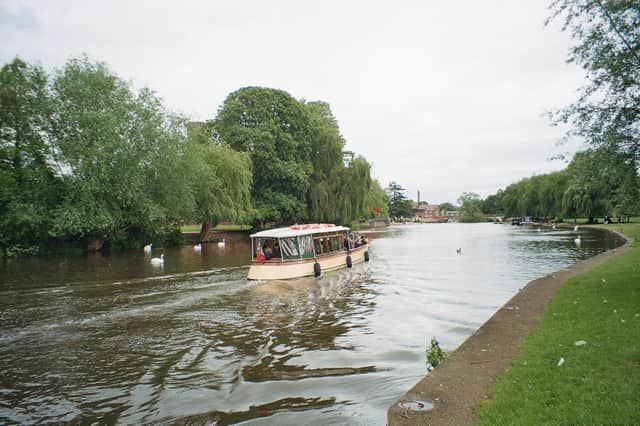Avon calling! Former Advertiser reporter celebrates a certain waterway that runs through Rugby


I’ve never made any secret of the fact that I was hardly a star pupil during my time at Lawrence Sheriff School.
But there was one way out for low achievers – or duffers, as they were called in less sensitive days – and that was through sport. If a boy could redeem themselves through rugby football or cricket, then much would be forgiven.
Advertisement
Hide AdAdvertisement
Hide AdThere was a keen rugby follower of a master at the school who never attempted to disguise his tendency to have favourites in the class. And if they possessed a Welsh surname like him, as well as being skilled on the playing field, then that was all the better.
It all became clear during morning roll call. The boys’ surnames would be called out in strict alphabetical order, and you were obliged to answer promptly and clearly, replying in just two words, these being ‘Yes, Sir!’
I was once belted hard across the head for missing out the ‘Sir’ bit. Yes, that’s what it was like in those days.
But when it came to our rugby player at the back of the class, there was a different approach entirely. He was addressed by his first name, this being followed by an adoring gaze from the grown up in the gown.
Advertisement
Hide AdAdvertisement
Hide AdUnfortunately for the adored one, the moment the master’s back was turned, the mickey-taking began… without mercy.
I never did well at rugby, especially after a kick to the stomach triggered a peritonitis that put me out of sporting action for several months. Instead, I opted for cross-country during the autumn and winter months.
Mind you, this was no walk in the park. Rather, it was a slog from Hart Field in Lower Hillmorton Road, skirting Abbot’s Farm estate, and at some stage wading across a shallow stretch of the River Avon.
I seem to recall this fordable location ran underneath a railway bridge and will never forget the icy water and the yellow-brown clay river bottom that eagerly and pitilessly tugged at your running shoes, as if they actually belonged to the river itself.
Advertisement
Hide AdAdvertisement
Hide AdYes, it’s hard to conjure up romantic images of Shakespeare’s Avon when you’ve lost a shoe in the mire, you’re freezing cold, and there’s an overcoated master on the opposite bank bawling at you to get a move on. You won’t find this scene in one of the Bard’s sonnets, believe me.
That said, the Avon will always be my favourite river. Rising near the Naseby battlefield in neighbouring Northamptonshire, it’s hardly got going by the time it reaches Rugby, only starting to fulfil its promise when it reaches the Lawfords, Bretford and Wolston.
Then of course, it’s all systems go on the approach to Warwick, which is where the Avon starts to assume the majesty that has made it one of England’s best loved rivers.
When I was a child growing up in Churchover, I was forever unearthing fossilised shells, a legacy of the days when this part of Britain was once covered by a vast, shallow inland sea that stretched from what it now southern Leicestershire to western Worcestershire.
Advertisement
Hide AdAdvertisement
Hide AdOn either side there were prehistoric cliffs that would one day be known as the Malvern Hills and the Cotswold escarpments.
In the north, the area where Rugby now stands would have been one enormous beach, which helps to explain the sand and gravel workings at and around Shawell.
A few years ago, I took a walk along Old Yard in Churchover, and into the fields beyond. In the days of my childhood, this had been pasture, in spring and early summer a riot of colour with the mauves and yellows of lady smocks and buttercups.
But now the land was ploughed. And it was because of this that the earth revealed some of its secrets, in this case a large fossil which now serves as a paperweight in my office back in Worcester,
Advertisement
Hide AdAdvertisement
Hide AdIt would have lain undetected for millennia, with generations of countless feet passing over its hiding place in the tilth… until a farmer’s plough awoke it from its age-long slumber.
I have a book on Midlands rivers and, sad to relate, the Avon doesn’t rate very highly as being very ecologically diverse as it passes through Rugby. In fact, it is probably a shadow of its former self. Years ago, I can recall spotting a pike hanging motionless on the weed fringes near the Avon Mill, but I doubt whether old Esox Lucius makes much of living in that vicinity these days.
But none of these considerations would have been uppermost in the mind of a certain schoolboy as he struggled and occasionally floundered in the mud on winter afternoons all those years ago.
For all I could think about then would have been the piping hot shower that lay ahead at the Hart Field pavilion, once my ordeal had ended.
Advertisement
Hide AdAdvertisement
Hide AdAnd all the time, that fossil would have been lying just inches below the surface of the soil near my childhood home, waiting for the day when it would be stirred from its sleep of ages.
John Phillpott’s book Beef Cubes and Burdock features more stories from his Churchover childhood. It can be obtained from booksellers or bought online at Amazon.